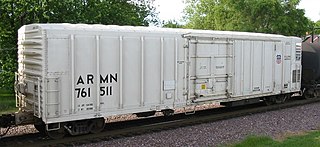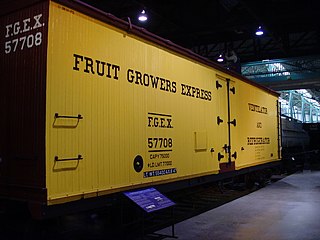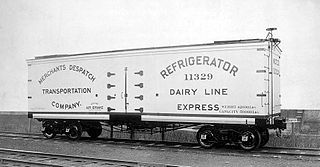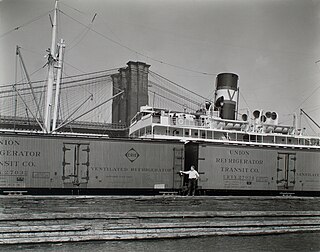This article needs additional citations for verification .(October 2011) |

Pacific Fruit Express( reporting mark PFE) was an American railroad refrigerator car leasing company that at one point was the largest refrigerator car operator in the world.
This article needs additional citations for verification .(October 2011) |

Pacific Fruit Express( reporting mark PFE) was an American railroad refrigerator car leasing company that at one point was the largest refrigerator car operator in the world.
The company was founded on December 7, 1906, as a joint venture between the Union Pacific and Southern Pacific railroads. It began operation on October 1, 1907, with a fleet of 6,600 refrigerator cars built by the American Car and Foundry Company (ACF). [1]
In 1923, the Western Pacific Railroad joined the venture by leasing its own new fleet of 2775 reefers to PFE. They were painted in standard PFE colors with only WP heralds on the cars instead of the paired UP-SP markings. The WP cars were all retired by the late 1950s, among the last wooden reefers in PFE's fleet. WP ended its partnership with PFE in late 1967 and joined Fruit Growers Express instead.
PFE's assets were divided between the UP and SP when the company was split on April 1, 1978. It is now a UP subsidiary. [2]
On September 1, 2022 Union Pacific closed the final Fruit Express shop in North Platte, Nebraska at Bailey Yard and all personnel and equipment were transferred to the North Platte Service Unit Car Department. [3]
Pacific Fruit Express Roster, 1907–1970:
| 1907 | 1910 | 1920 | 1930 | 1940 | 1950 | 1960 | 1970 |
| 6,600 | 8,100 | 16,000 | 40,509 | 36,899 | 38,840 | 28,818 | 17,648 |
Source: The Great Yellow Fleet, p. 17.
Modern cars owned by PFE typically carried both UP and SP heralds and either "Union Pacific Fruit Express" or "Southern Pacific Fruit Express". The reporting marks were UPFE for cars operated by Union Pacific or SPFE for cars operated by Southern Pacific.
PFE's impact is still seen in Roseville, California, site of a major Union Pacific classification yard, where there is a road named "PFE Road".
There are a pair of PFE tracks in the Union Pacific Albina Yard in Portland, Oregon
There is PFE track in Tucson Yard Tucson, Az.
PFE shops in Pocatello, Idaho are still used by the car department.
A PFE boxcar is on final display in Cody Park in North Platte, Nebraska behind Centennial 6922.

The Union Pacific Railroad is a Class I freight-hauling railroad that operates 8,300 locomotives over 32,200 miles (51,800 km) routes in 23 U.S. states west of Chicago and New Orleans. Union Pacific is the second largest railroad in the United States after BNSF, with which it shares a duopoly on transcontinental freight rail lines in the Western, Midwestern and West South Central United States.

BNSF Railway is the largest freight railroad in the United States. One of six North American Class I railroads, BNSF has 36,000 employees, 33,400 miles (53,800 km) of track in 28 states, and over 8,000 locomotives. It has three transcontinental routes that provide rail connections between the western and eastern United States. BNSF trains traveled over 169 million miles in 2010, more than any other North American railroad.

The Southern Pacific was an American Class I railroad network that existed from 1865 to 1996 and operated largely in the Western United States. The system was operated by various companies under the names Southern Pacific Railroad, Southern Pacific Company and Southern Pacific Transportation Company.

The Chicago, Burlington and Quincy Railroad was a railroad that operated in the Midwestern United States. Commonly referred to as the Burlington Route, the Burlington, or as the Q, it operated extensive trackage in the states of Colorado, Illinois, Iowa, Missouri, Nebraska, Wisconsin, Wyoming, and also in Texas through subsidiaries Colorado and Southern Railway, Fort Worth and Denver Railway, and Burlington-Rock Island Railroad. Its primary connections included Chicago, Minneapolis–Saint Paul, St. Louis, Kansas City, and Denver. Because of this extensive trackage in the midwest and mountain states, the railroad used the advertising slogans "Everywhere West", "Way of the Zephyrs", and "The Way West".

A refrigerator car is a refrigerated boxcar (U.S.), a piece of railroad rolling stock designed to carry perishable freight at specific temperatures. Refrigerator cars differ from simple insulated boxcars and ventilated boxcars, neither of which are fitted with cooling apparatus. Reefers can be ice-cooled, come equipped with any one of a variety of mechanical refrigeration systems, or utilize carbon dioxide as a cooling agent. Milk cars may or may not include a cooling system, but are equipped with high-speed trucks and other modifications that allow them to travel with passenger trains.

An autorack, also known as an auto carrier, is a specialized piece of railroad rolling stock used to transport automobiles and light trucks. Autoracks are used to transport new vehicles from factories to automotive distributors, and to transport passengers' vehicles in car shuttles and motorail services, such as Amtrak's Auto Train route.

The Arizona Railway Museum is a railroad museum located in Chandler, Arizona.

Fruit Growers Express (FGE) was a railroad refrigerator car leasing company that began as a produce-hauling subsidiary of Armour and Company's private refrigerator car line. Armour controlled both the packing operations and the transport insulated railroad car line, and its customers had complained they were overcharged. In 1919 the Federal Trade Commission ordered the company's spinoff of Fruit Growers Express for antitrust reasons, which was accomplished by 1920.
Burlington Refrigerator Express (BREX) was a railroad refrigerator car leasing company that was formed on May 1, 1926 as a joint venture between the Chicago, Burlington and Quincy Railroad (CB&Q) and the Fruit Growers Express Company. The move helped the FGE expand its business into the Pacific Northwest, and added almost 2,700 ice bunker units to the existing car pool already under lease by the Burlington to the FGE and Western Fruit Express (WFE).

Western Fruit Express (WFE) was a railroad refrigerator car leasing company formed by the Fruit Growers Express and the Great Northern Railway on July 18, 1923 in order to compete with the Pacific Fruit Express and Santa Fe Refrigerator Despatch in the Western United States. The arrangement added 3,000 cars to the FGE's existing equipment pool. It is now a wholly owned subsidiary of the Burlington Northern Santa Fe Corporation (BNSF), the Great Northern's successor. The success of the WFE led to the creation of the Burlington Refrigerator Express (BREX) in May 1926.

The Merchants Despatch Transportation Company was established in 1857 or 1858 by the American Express Company of New York. The entity was reformed as a joint stock trading company on June 1, 1869, with ownership divided among the Cleveland, Columbus, Cincinnati and Indianapolis Railway (CCC&I), the Lake Shore and Michigan Southern Railway, and the New York Central Railroad (NYC), all part of the Cornelius Vanderbilt rail empire.

Two distinct and separate railroad refrigerator car companies have operated under the name Western Refrigerator Line.

The Union Refrigerator Transit Line (URT) was a St. Louis, Missouri- and Milwaukee, Wisconsin-based private refrigerator car line established in 1895 by the Joseph Schlitz Brewing Company. In 1929, the General American Tank Car Corporation acquired the URT and placed its rolling stock into lease service. In the early 1970s the company, then operating as the General American Transportation Corporation (GATX) liquidated its URT subsidiary along with its outdated wooden reefer fleet.
The North Western Refrigerator Line (NWX) was a Chicago, Illinois-based private refrigerator car line established in 1924, one of the last such companies to be formed. Between 1924 and 1940 the company acquired more than 3,000 new wood refrigerator cars originally built by the American Car and Foundry Company, and leased the former Ringling Brothers Circus railroad car plant in Baraboo, Wisconsin to serve as a car shop.
The history of the Southern Pacific ("SP") stretched from 1865 to 1998.